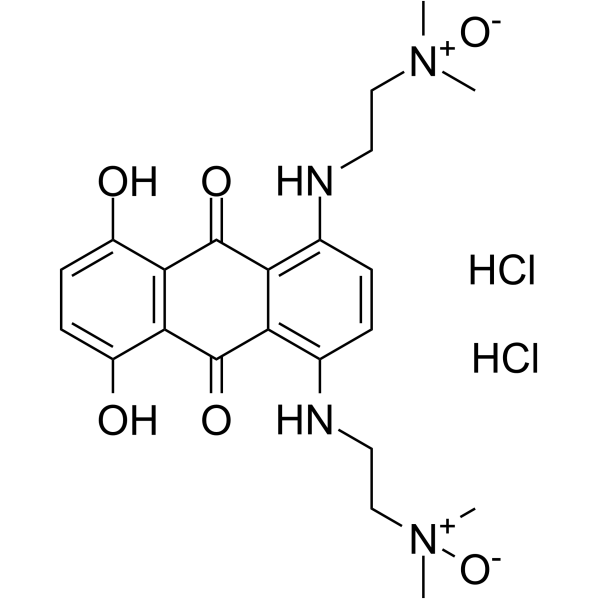上海金畔生物科技有限公司为生命科学和医药研发人员提供生物活性分子抑制剂、激动剂、特异性抑制剂、化合物库、重组蛋白,专注于信号通路和疾病研究领域。
Banoxantrone dihydrochloride (Synonyms: AQ4N dihydrochloride) 纯度: 99.17%
Banoxantrone dihydrochloride 是一种新型生物还原剂,可还原成稳定的 DNA 亲和性化合物 AQ4,AQ4 是一种有效的拓扑异构酶II抑制剂。

Banoxantrone dihydrochloride Chemical Structure
CAS No. : 252979-56-9
| 规格 | 价格 | 是否有货 | 数量 |
|---|---|---|---|
| 10 mM * 1 mL in DMSO | ¥1081 | In-stock | |
| 5 mg | ¥950 | In-stock | |
| 10 mg | ¥1650 | In-stock | |
| 25 mg | ¥3700 | In-stock | |
| 50 mg | 询价 | ||
| 100 mg | 询价 |
* Please select Quantity before adding items.
Banoxantrone dihydrochloride 相关产品
•相关化合物库:
- Natural Product Like Compound Library
- Bioactive Compound Library Plus
- Cell Cycle/DNA Damage Compound Library
- Anti-Cancer Compound Library
- Anti-Aging Compound Library
- Anti-Lung Cancer Compound Library
- Anti-Blood Cancer Compound Library
| 生物活性 |
Banoxantrone dihydrochloride is a novel bioreductive agent that can be reduced to a stable, DNA-affinic compound AQ4, which is a potent topoisomerase II inhibitor. |
||||||||||||||||
|---|---|---|---|---|---|---|---|---|---|---|---|---|---|---|---|---|---|
| IC50 & Target[1] |
|
||||||||||||||||
| 体外研究 (In Vitro) |
Banoxantrone (AQ4N) can be reduced in a hypoxic environment to a stable DNA-affinic agent AQ4. AQ4, a potent topoisomerase II inhibitor, would be capable of damaging cells recruited into the cell cycle following radiation damage to the well-oxygenated cells of the tumor[1]. Banoxantrone shows more than 8-fold higher cytotoxicity under hypoxia than normoxia in cultures of 9L rat gliosarcoma and H460 human non-small-cell lung carcinoma cells but not for 11 other human cancer cell lines. DT-diaphorase protein levels and banoxantrone chemosensitivity are poorly correlated across the cancer cell line panel, and banoxantrone chemosensitivity is not affected by DT-diaphorase inhibitors[2]. Banoxantrone is a bis-N-oxide that is reduced via two sequential two-electron reductions to the tertiary amine, AQ4, which is a potent cytotoxic agent toward both aerobic and hypoxic cells. AQ4, but not AQ4N, intercalates in DNA with high affinity to generate a stable persistent complex that can inhibit topoisomerase II and cause DNA damage and cell death[3]. 上海金畔生物科技有限公司 has not independently confirmed the accuracy of these methods. They are for reference only. |
||||||||||||||||
| 体内研究 (In Vivo) |
Banoxantrone (200 mg/kg) significantly enhances the tumor growth delay caused by radiation. This occurred when radiation is administered both as a single dose (12 Gy) and in a multifraction regimen (5×3 Gy). A study of the scheduling of Banoxantrone (AQ4N) administration shows that there is a very long time period over which a maximal effect can be elicited (drug given 4 days before to 6 h after radiation). These results suggest that Banoxantrone has significant potential as a bioreductive drug[1]. The activation of banoxantrone cytotoxicity in vivo requires tumor hypoxia that is more extensive or prolonged than can readily be achieved by vasodilation or by antiangiogenic drug treatment[2]. Incorporation of banoxantrone into conventional chemoradiation protocols therefore targets both oxygenated and hypoxic regions of tumors, and potentially will increase the effectiveness of therapy. A single dose of 60 mg/kg banoxantrone enhances the response of RT112 (bladder) and Calu-6 (lung) xenografts to treatment with cisplatin and radiation therapy. Banoxantrone will increase the efficacy of chemoradiotherapy in preclinical models[3]. 上海金畔生物科技有限公司 has not independently confirmed the accuracy of these methods. They are for reference only. |
||||||||||||||||
| 分子量 |
517.40 |
||||||||||||||||
| Formula |
C22H30Cl2N4O6 |
||||||||||||||||
| CAS 号 |
252979-56-9 |
||||||||||||||||
| 运输条件 |
Room temperature in continental US; may vary elsewhere. |
||||||||||||||||
| 储存方式 |
-20°C, protect from light, stored under nitrogen *In solvent : -80°C, 6 months; -20°C, 1 month (protect from light, stored under nitrogen) |
||||||||||||||||
| 溶解性数据 |
In Vitro:
DMSO : 100 mg/mL (193.27 mM; Need ultrasonic) H2O : 25 mg/mL (48.32 mM; Need ultrasonic and warming) 配制储备液
*
请根据产品在不同溶剂中的溶解度选择合适的溶剂配制储备液;一旦配成溶液,请分装保存,避免反复冻融造成的产品失效。 In Vivo:
请根据您的实验动物和给药方式选择适当的溶解方案。以下溶解方案都请先按照 In Vitro 方式配制澄清的储备液,再依次添加助溶剂: ——为保证实验结果的可靠性,澄清的储备液可以根据储存条件,适当保存;体内实验的工作液,建议您现用现配,当天使用; 以下溶剂前显示的百
|
||||||||||||||||
| 参考文献 |
|
| Kinase Assay [1] |
Untreated T50/80 tumors (6.5-9.0 mm geometric diameter (GMD) are excised and gently disaggregated by mechanical disruption in ice-cold phosphate-buffered saline (PBS). Single cell suspensions are prepared by filtration through a 40μm mesh. These are then centrifuged and resuspended in Eagle’s minimal essential medium (EMEM) containing 10% fetal calf serum (FCS) at a concentration of 106 cells/mL. Cells (20 mL) are placed in 125 mL rubber sealed glass bottles. These are gassed for 2 h at 37°C to provide welloxygenated conditions, i.e. 95% air/5% carbon dioxide or hypoxic conditions 95% N2/5% CO2. Banoxantrone (AQ4N) (20μM) is added for the last 90 min of this period by injection through the sealed lid. Drug is washed off and cells resuspended in fresh medium. For analysis of DNA damage, aliquots (105 cells) are processed at various times ranging from 0 to 96 h after this procedure. To evaluate the effect of maintaining the excised tumor cells in culture, samples are also maintained in the culture medium above at 37°C, 95% air/5% CO2 for 24 h. The cells, which grow in suspension, are then harvested and placed in glass bottles and the experiment outlined above is carried out. Each experiment is carried out twice and the results pooled[1]. 上海金畔生物科技有限公司 has not independently confirmed the accuracy of these methods. They are for reference only. |
|---|---|
| Animal Administration [1] |
Mice[1] 上海金畔生物科技有限公司 has not independently confirmed the accuracy of these methods. They are for reference only. |
| 参考文献 |
|
所有产品仅用作科学研究或药证申报,我们不为任何个人用途提供产品和服务
